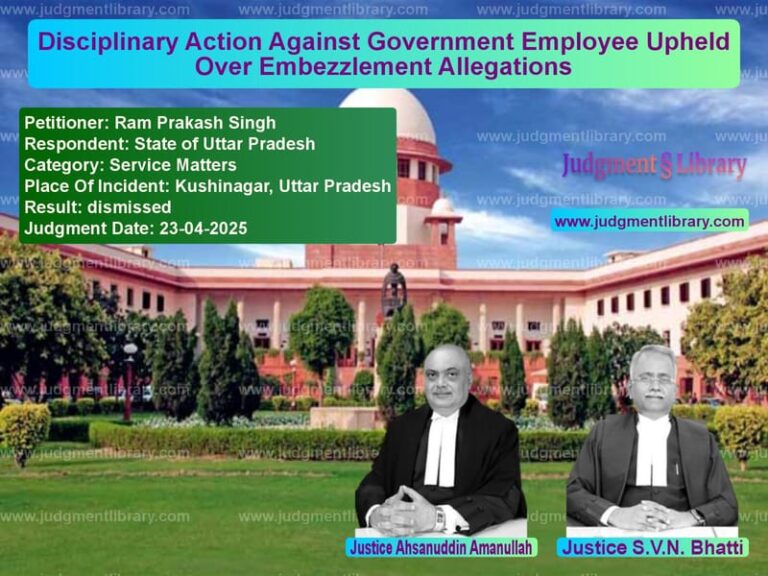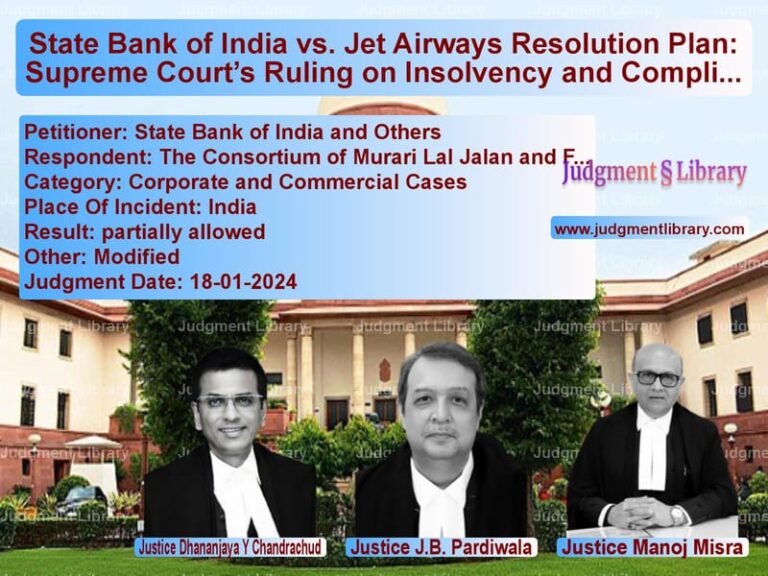Encroachment on Panchayat Land: Supreme Court Orders Removal of Illegal Occupants
The Supreme Court of India has recently delivered a landmark judgment in the case of The State of Haryana & Ors. v. Satpal & Ors., addressing the long-standing issue of illegal encroachment on village common land. The case revolved around the unauthorized occupation of Gram Panchayat land by individuals who had constructed residential properties and refused to vacate despite multiple eviction orders.
The judgment provides significant clarity on the rights of local authorities to reclaim land earmarked for public use, particularly in cases where such land has been illegally occupied. The Court overturned a Punjab and Haryana High Court ruling that had directed the authorities to legalize the encroachments upon payment of market price.
Background of the Case
The case arose from an eviction order passed by the Assistant Collector, Mustafabad, on 30.08.2011, directing the removal of unauthorized occupants from Khasra Nos. 61/2 and 62, which belonged to the Gram Panchayat. The order was upheld by the Collector and subsequently by the Commissioner. However, the encroachers challenged the orders before the High Court of Punjab and Haryana.
In its ruling dated 12.05.2016, the High Court suggested that the Gram Panchayat could either accept double the land in exchange or recover the market value from the encroachers. This effectively allowed illegal occupants to retain possession upon payment. The State of Haryana, dissatisfied with this ruling, approached the Supreme Court.
Petitioner’s Arguments (State of Haryana)
The State of Haryana, represented by its counsel, made the following key arguments:
- The High Court’s decision to legalize encroachments was erroneous and contrary to law.
- The Gram Panchayat land was earmarked for public purposes, specifically as a school and playground.
- The respondents had been in unauthorized possession despite multiple orders directing eviction.
- The High Court’s direction was not practical, as segregation of the occupied land from vacant land was not feasible.
- Encroachments on public land should not be regularized, as it would set a wrong precedent.
Respondent’s Arguments (Satpal & Ors.)
The respondents argued that:
- They had been residing on the land for a long time and had developed permanent structures.
- They were willing to either provide alternative land to the Gram Panchayat or pay the market price.
- The High Court’s solution was practical and allowed for a fair resolution.
- There were no immediate plans for the land’s utilization, and allowing them to stay would not harm public interest.
Supreme Court’s Judgment
The Supreme Court bench, comprising M.R. Shah and B.V. Nagarathna, rejected the High Court’s ruling and emphasized the importance of protecting public land. The Court held:
“The unauthorized occupation and possession of the land, which is reserved for the school and the playground, cannot be directed to be legalized. There cannot be any school without a playground. Even the students, who study in such a school, are entitled to a good environment.”
The Court further ruled:
- The High Court erred in allowing encroachers to retain possession by paying market value.
- There was no alternative land available to substitute for the occupied land.
- The respondents were granted 12 months to vacate the land voluntarily.
- If they failed to vacate within the stipulated period, the authorities were directed to forcibly remove them.
Implications of the Judgment
This ruling has significant implications for land governance in India:
- Encroachments on public land will not be legalized, even upon payment.
- Local authorities are empowered to reclaim land meant for public purposes.
- Public amenities such as schools and playgrounds must be preserved.
- The ruling discourages illegal occupation by setting a strict precedent.
Conclusion
The Supreme Court’s decision in The State of Haryana v. Satpal reaffirms the principle that public land cannot be encroached upon and later claimed through payment. The ruling ensures that essential public infrastructure remains protected and available for the communities they are meant to serve.
With a strict deadline for eviction, the ruling sets an important precedent that will likely influence future cases of land encroachment across the country.
Petitioner Name: The State of Haryana.Respondent Name: Satpal & Ors..Judgment By: Justice M.R. Shah, Justice B.V. Nagarathna.Place Of Incident: Haryana.Judgment Date: 02-03-2023.
Don’t miss out on the full details! Download the complete judgment in PDF format below and gain valuable insights instantly!
Download Judgment: the-state-of-haryana-vs-satpal-&-ors.-supreme-court-of-india-judgment-dated-02-03-2023.pdf
Directly Download Judgment: Directly download this Judgment
See all petitions in Property Disputes
See all petitions in Landlord-Tenant Disputes
See all petitions in Damages and Compensation
See all petitions in Specific Performance
See all petitions in Judgment by Mukeshkumar Rasikbhai Shah
See all petitions in Judgment by B.V. Nagarathna
See all petitions in allowed
See all petitions in supreme court of India judgments March 2023
See all petitions in 2023 judgments
See all posts in Civil Cases Category
See all allowed petitions in Civil Cases Category
See all Dismissed petitions in Civil Cases Category
See all partially allowed petitions in Civil Cases Category







